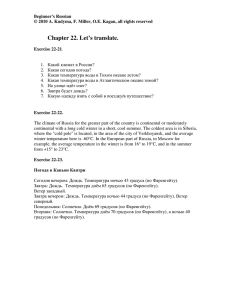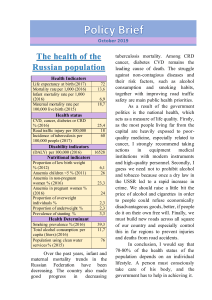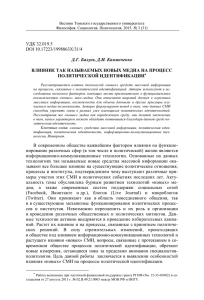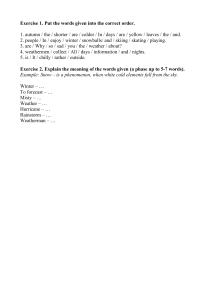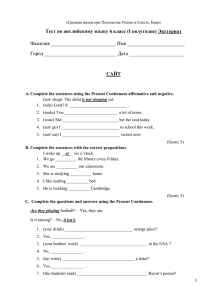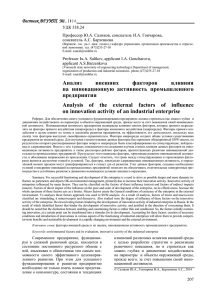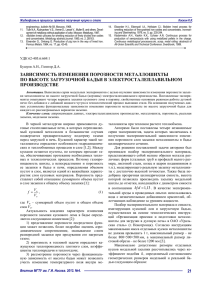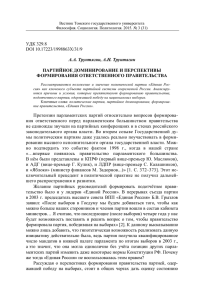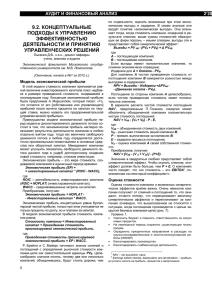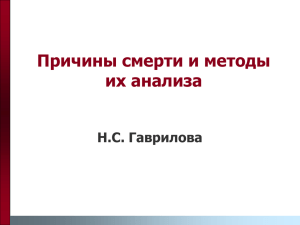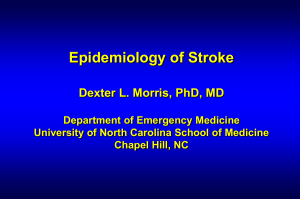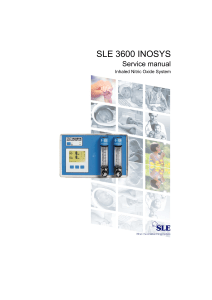Специальный доклад по этой теме
реклама
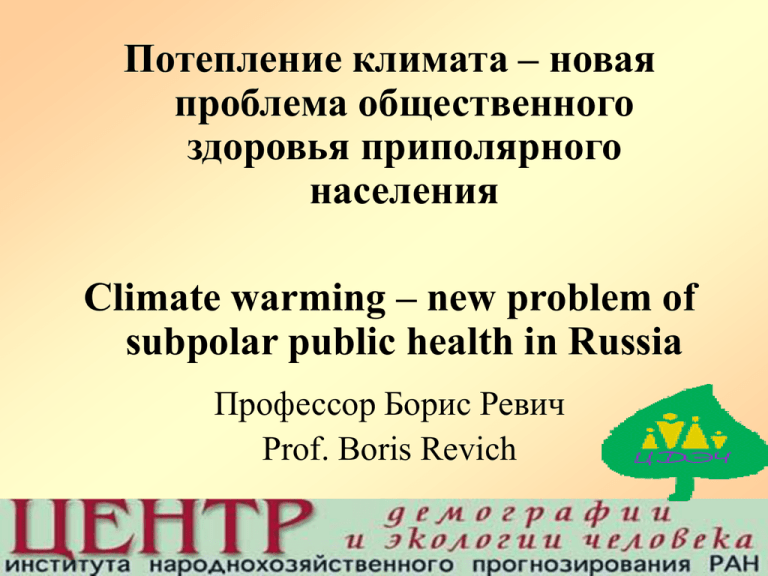
Потепление климата – новая проблема общественного здоровья приполярного населения Climate warming – new problem of subpolar public health in Russia Профессор Борис Ревич Prof. Boris Revich Аномалии осредненной по территории России среднегодовой температуры воздуха за период 1936-2005 гг. (www.meteorf.ru/klimat05) T (o C) 2,5 2,0 1,5 2005 1,0 0,5 0,0 -0,5 -1,0 -1,5 = 0.14oC/10 лет 2000 2004 1996 1992 1984 1988 1976 1980 1968 1972 1960 1964 1956 1952 1940 1944 1948 1936 -2,0 T –Yakutsk-1950-1995 -4 1950 -5 -6 -7 -8 -9 -10 -11 -12 1953 1956 1959 1962 1965 1968 1971 1974 1977 1980 1983 1986 1989 1992 1995 Ожидаемые к середине ХХI века изменения средней годовой температуры воздуха для основных регионов России Expected by 2050 Increments of Annual Average Temperatures in Russian Regions Регион Region Прогноз увеличения среднегодовой температуры ºС Temperature Increase, ºС Центральный / Central 0.5-1.0 Северо-Западный /North-West 0-1 Север ЕТС/European North 2-3 Арктическое Побережье /Arctic Coast 2-3 Западная Сибирь/West Siberia 3-4 Якутия/Yakutia 2-3 Дальний Восток/Far East 1-2 Национальный доклад по проблемам изменения климата Минэкономразвития России, National Report on Climate Change, Ministry of Economic Development, 2003 Изменение климата и здоровье в северной России – инфекционные заболевания !!!Геморрагические лихорадки– движение на север !! Деградация территорий вечной мерзлоты – проблемы с инженерными коммуникациями Сокращение площадей на 12-15%, перемещение границы на 160-200 км севернее ОКИ , Якутия, 2001, брюшной тиф !! Паразитозы – дирофиляриатоз – движение на север ! Псевдотуберкулез, листериоз !? Клещевой энцефалит, туляремия Потепление климатаинфекционные заболевания Лихорадка Западного Нила – в 1999 году – вспышки заболевания среди жителей Волгоградской и Астраханской областей, Краснодарского края. Число случаев ЛЗН Лихорадка Западного Нила в России в 1999 г. 500 >500 400 300 200 100 0 >5 1997 >35 1998 32 1999 2000 Краснодар Волгоград Астрахань Волгоград (> 500 случаев, 38 смертей); Астрахань (> 90 случаев, 5 смертей); Краснодар (> 40 случаев, 3 смерти). А.Е.Платонов, ЦНИИ эпидемиологии МЗ РФ 15 2001 14 2002 Клещевой энцефалит Более раннее начало периода нападения клещей на людей (СевероЗапад России) Рост заболеваемости клещевым энцефалитом - в год заболевает 5-10 тыс. человек Расширение ареала за счет СевероЗападного и Приволжского регионов. Высокие показатели заболеваемости в Сибири и на Дальнем Востоке Ixodes Persulcatus – сдвиг теплового барьерав Якутии _!!!!!!!!!!!!!!!!!!!!!!!!!!!!!!! Геморрагические лихорадки Лихорадка Крым-Конго. Южные регионы России, летальные исходы Омская геморрагическая лихорадка - Природные очаги в Западной Сибири и Казахстане. Тенденция к ее возвращению и распространению на север. Особо опасные инфекции Сибирская язва: Большое количество стационарно неблагополучных пунктов по сибирской язве. Возбудитель сибирской язвы в виде спор может десятки лет находиться в почве. В случае потепления в зонах вечной мерзлоты могут создаться благоприятные условия для вегетации бактерий с высоко вероятным инфицированием восприимчивых животных и опосредованно заражением людей. Наводнения на севере России 1998, май Вологодская область Эвакуировано 10 тыс. г. В. Устюг человек 1998, май 2001, май 8/06/2006 Ленск, Якутия 172 нас. пункта В зоне затопления 475 тыс. человек, Эвакуировано 50 тыс. человек, t днем +1 +3 °С ночь -10 -12 °С, снег Ленск, Якутия Эвакуация 23 тыс. 172 нас. пункта человек,больницы Таймыр ? Олекминск, Якутия T and Public Health: Arctic and Subarctic cities, 7 - more 100 thous. peoples 13 - more 20 thous.peoples Urban population -2 2000th Project: Climate, Air Pollution and Mortality in Moscow in 2000-2005 • Center of Demography and Human Ecology of Institute of Forecasting, Russian Academy of Science, Moscow • Environmental Monitoring • Meteorology Observatory of Moscow State University • Environmental Defense (USA) Variations and Trend of Annual Average Temperatures in Moscow in 1900-2000 Т, С 8 7 6 5 4 3 2 2000 1995 1990 1985 1980 1975 1970 1965 1960 1955 1950 1945 1940 1935 1930 1925 1920 1915 1910 1905 1900 1 Source: Moscow Environment and Climate Reference Book, 2003, vol.1, 173. Т, С 10 Annual Average Temperature in Moscow (MSU Meteo Observatory) in 1954-2001 and ЕСНАМ4 model forecast till 2050 [Sherstukov, 2005] 9 8 7 6 5 4 3 2 2046 2039 2034 2026 2019 2014 2006 1999 1994 1986 1979 1974 1966 1959 1954 1 Summer vs. winter concentrations of РМ10, NO2 and O3 in 2000-05, ug/m3 (MosEcoMonitoring data) Winter Summer РМ 10 30,7 33,0 NO2 42,0 35,4 О3 19,3 26,2 Regression Equation of Daily Pollution on Daily Temperature Pollution = Const +βTlag + ε Summer (2003 – 2005) Regression coefficients of proportionality between NO2 and T with different time lags in days 1,8 Slope factor, ug/m3/degree C 1,6 1,4 1,2 1,0 0,8 0,6 0,4 0,2 0,0 -8,0 -6,0 -4,0 -2,0 0,0 2,0 lag between T and Concentration, days 4,0 6,0 Summer (2003 – 2005) Regression coefficients of proportionality between PM10 and T with different time lags in days 2,00 Slope factor, ug/m3/degree C 1,80 1,60 1,40 1,20 1,00 0,80 0,60 0,40 0,20 0,00 -8,0 -6,0 -4,0 -2,0 0,0 Lag, days 2,0 4,0 6,0 Summer Т and Concentrations wave in August of 2004 70,0 60,0 50,0 T 40,0 NO2 30,0 O3 20,0 PM10 10,0 0,0 17.08.04 19.08.04 21.08.04 23.08.04 25.08.04 Winter (2003 – 2005) Regression coefficients of proportionality between PM10 and T with different time lags PM10 Slope factor, ug/m3/degree C 0,00 -8 -6 -4 -2 -0,20 0 -0,40 -0,60 -0,80 -1,00 -1,20 -1,40 -1,60 -1,80 Lag, days 2 4 6 8 Number of days with extremely high (in summer) and extremely low (in winter) daily average temperatures in 2000 – 2005 Threshold for temperature anomaly + 20.2 + 21.8 + 20.1 June July August December January February 2000 5 2 0 0 3 0 2001 4 20 7 10 0 4 2002 8 21 8 12 3 0 2003 0 12 4 0 6 3 2004 3 4 14 0 0 2 2005 3 7 8 0 0 0 10 18 2006 - 13.2 - 16.4 - 14.7 • Summer Heat Waves: 2001 and 2002. • Energy system failure, “Black-out” of May 25th, 2005 Heat wave of July’01 and consequent increase of daily mortality from all causes, all ages 200,0 150,0 100,0 50,0 0,0 -50,028 июн 8 июл 18 июл 28 июл 7 авг 17 авг -100,0 T above average Mortality above background 27 авг 6 сен Moscow, Summer’02 • Extremely high temperatures: 16 days with daily Тmax above 29 °С, accompanied with smog situation – 27 days with haze, high level of air pollution • Low visibility on highways • Airports in Moscow Region closed for weather • Smell of smoke, “empyreuma” • Eye irritation, breathing problems, headache, etc. Results of regression analysis – T-related increase in daily mortality •Total mortality of males: Yt = 146 + (1.18±0.45)T0 •IHD of males: Yt = 33 + (0.51±0.19)T0 Results of regression analysis – temperature-related increase in daily mortality • Cerebrovascular diseases of males: Yt = 23.6 + (0.6±0.2)T0 , Yt = 14.7 + (0.98±0.19)T-1 (T-1 –temperature on previous day ) • Mortality of males from external causes: Yt = 18.9 + (0.40±0.19)T0 Health consequences of heat wave in July’02 632 additional deaths as direct result of heat wave Moscow. May 25th, 2005 • Warm weather • Accident at thermal power station • Sharp increase of PM10 concentrations: from average value of 33 ug/m3 to extreme of 71 ug/m3, NO2 concentrations within the norm (MosEcoMonitoring data) Cold wave – January’06 Age group 75 +: •142 additional deaths from all causes ( except external), •including 61 additional deaths from IHD Т, air pollution and mortality in Moscow in 2002 – 2005 4 causes included in the analysis: All cases, except external IHD (I20-25) Cerebrovascular diseases (myocardial infarction, cerebrovascular accidents) (I 60-69) Chronic lower respiratory diseases (bronchitis, emphysema, asthma, asthmatic status) (J40-47) Seasonal variations of mortality from all causes (except external) in age group 75+. 30-day moving average for 2000 – 2004 200,0 180,0 Winter Winter Winter 2000 2001 2002 Winter 2003 Winter 2004 daily mortality 160,0 140,0 120,0 100,0 summer 2000 summer 2001 summer 2002 summer 2003 summer 2004 80,0 60,0 40,0 20,0 0,0 24.07.98 06.12.99 19.04.01 01.09.02 14.01.04 28.05.05 Monthly average mortality from ischaemia in age group 75+ (2002-2005) avg. daily value 75 70 65 60 55 50 1 2 3 4 5 6 7 month 8 9 10 11 12 Т-mortality curve for Moscow and “T of maximum comfort” (2000-2005) 480,0 Mort 450,0 420,0 390,0 360,0 330,0 -30 -20 -10 0 T 10 20 30 Daily Mortality-T relationship in Moscow, 2000 - 2005 • Moscow: linear decrease from -20 to +19 °С [Revich, Golub, Shaposhnikov, 2006] • London: linear decrease from 0 to +150C [Keatinge, Donaldson, 2001] Results of regression analysis Relative risks were calculated for: • 8 causes of mortality (4 causes and 2 age groups) • and time lags 0, 1, …, 6 days … and risk factors: • Temperature increase above maximum comfort (+19ºС) • Temperature decrease below maximum comfort (+19ºС) • Increments of daily average concentrations of PM10,, NO2, and O3 by 10 µg/м3 Examples of relative risks of variation of daily average temperature by 1ºC Cases RR of summer heat (T>20ºC) RR of cold temperatures (T<19ºC) All causes (except external), all ages Chronic lower respiratory diseases, all ages 2.8% (2.0%; 3.6%) -0.44% (-0.40%; -0.48%) 8.7% (0.7%; 16.7%) -1.31% (-1.75%; -0.87%) Primer of mortality/temperature depencency with different time lags Cerebrovascular mortality, age group 75+ relative risk, %/C 6 5 4 3 2 1 0 -8 -6 -4 -2 time lag, days before death 0 Relative risks of mortality per 10 µg/м3 increase of daily average concentration of pollutant Causes Age group PM10 NO2 O3 All (except external) All ages 75+ All ages 75+ 0.48 0.96 - 0.39 - 0.57 4.9 7.8 All ages 75+ All ages 75+ 0.76 1.11 0.94 1.39 0.66 1.02 1.10 1.55 1.23 Chronic lower respiratory IHD Cerebrovas cular Low Temperatures as Health Risk Factor in Russia • North territories make about 64% of total area of the RF • Cold discomfort • Cardio-vascular system • Respiratory tract • Mortality from frostbite • In Russia, about 1,500 people die from frostbite every year, predominantly males over 20y.o. • There are no deaths cased by frostbite registered in European countries with cold climate (Norway, Denmark, Sweden, Finland, Iceland) Climate Change and Human Health in Russian Arctic Region • Infections diseases - Infrastructure break-downs in cryolite zone ! • Emergence and new infectious diseases and parasitosis of sea mammals and humans ? • Change in food – dietary problems ? • Changes in air quality - ? • Problems with traditional hunting of northern aborigines - ! WWF-Russia climate programme Observations of Climate Change Made by Indigenous Inhabitants of the Coastal Regions of Chukotka Majority of people survived have noticed climate changes Affirmative 89% Negative 11% Vladilen Ivanovich Kavry 39 years of age Chukchi Marine Mammal Hunter Has noticed significant climate changes. Ice breaks up a month earlier than it did before. Old ice no longer exists. Walrus stay longer at haul out sites. Birds depart later. Required research of climate/health in Russia • Infectious diseases and T relationship • Mortality and T relationship in different climate zones (North, Siberia, Far East) • Climate warming and traditional crafts in Arctic The following documents should be prepared: • National Climate Health Impact Assessment • Scientific Report about Climate change and health at Russian Arctic • National Climate Health Action Plan (as French “Plan Canicule”, UK, Germany, Spain, Finland, etc.) Спасибо за внимание ! Thank you for attention!!
